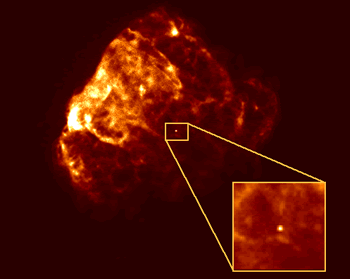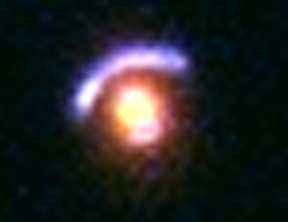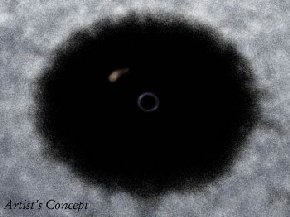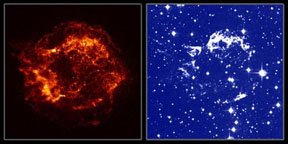The X-ray light image of the cloud Cassiopeia A versus the visible light image. If you look very closely, you can see a small bright spot near the middle of the cloud in the X-ray image. Scientists say this may be a neutron star or black hole.
Click on image for full size
Courtesy of NASA and the SAO Chandra X-ray Center
NASA Reveals First Images from Chandra
News story originally written on August 27, 1999
NASA revealed the first images from the Chandra X Observatory. Since first being deployed July 23, the Chandra X Observatory has had no problems. Included in the first set are images of a huge cloud with either a neutron star or black hole inside it.
NASA believes the powerful telescope will reveal black holes hiding in the universe. The Chandra takes images using X-rays instead of visual light. X-rays are usually released by really hot objects. Many of these objects cannot be seen with normal light, which means the Hubble Space Telescope cannot see them.
You might also be interested in:

Neutron Stars form when really big stars die. When such a star runs out of fuel its center begins to collapse under gravity. When the center collapses the entire star collapses. The surface of the star
...more
Some really cool pictures were taken by NASA's Hubble Space Telescope! The gravity of galaxies and black holes is able to bend the light coming from behind it. This makes a lens of light around the object.
...more
Everyone likes hearing about black holes. They are so mysterious! Scientists using the Chandra X-ray Observatory and the Hubble Space Telescope have found material spiraling into black holes! Both teams
...more
It was another exciting and frustrating year for the space science program. It seemed that every step forward led to one backwards. Either way, NASA led the way to a great century of discovery. Unfortunately,
...more
The Space Shuttle Discovery lifted off from Kennedy Space Center on October 29th at 2:19 p.m. EST. The sky was clear and the weather was great. This was the America's 123rd manned space mission. A huge
...more
Scientists found a satellite orbiting the asteroid, Eugenia. This is the second one ever! A special telescope allows scientists to look through Earth's atmosphere. The first satellite found was Dactyl.
...more
The United States wants Russia to put the service module in orbit! The module is part of the International Space Station. It was supposed to be in space over 2 years ago. Russia just sent supplies to the
...more















